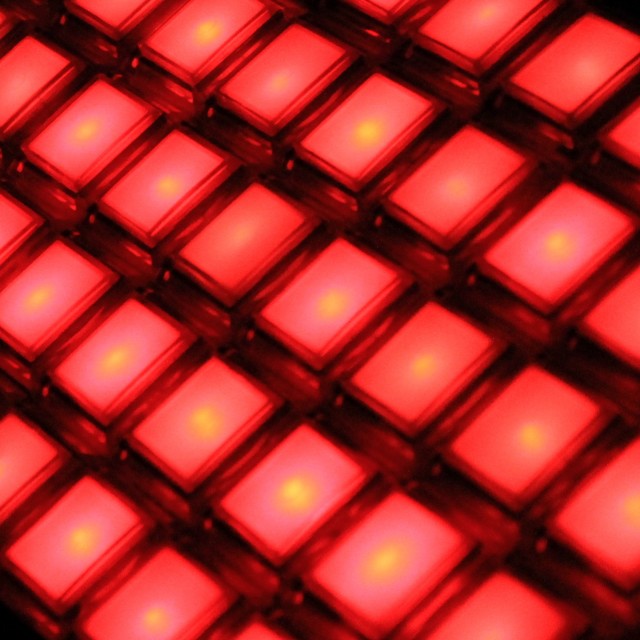Minneapolis-based artist Patrick Flanagan is no ordinary drummer or electronic musician. His rig does everything the hard way – and the results are fantastic. With robotic drum kit mechanically playing acoustic drums, his fingers command complex feats of rhythm and melody from an oversized, custom grid controller.
There are idiomatic musical possibilities unlocked by software he’s built in Max/MSP and Java. Repeat increments, of the sort found in drum machines, produce complex rhythmic figuration on multiple drums – partly because, unlike the dumber implementation on drum machines, it’s possible to play multiple repeat increments at the same time. (In other words, you can have one drum playing eights while another plays sixteenths.) In melodies, his layout make big octave jumps easier – think Giant Steps.

Mega, indeed. Apart from using the Arduino mega, Patrick Flanagan’s controller has a big scale and big ambitions. Image courtesy the artist.
Patrick writes with more details:
I just uploaded a demo video for my custom grid-based controller, the Meganome. The design is obviously inspired by the monome, but it departs in a couple ways from the monome and its cousins. I wanted larger buttons with light but solid action for triggering drum hits and synth notes–buttons that are hard to miss and give you a nice “clack” sound when struck. The rectangular arrangement with 14 buttons per row lets me display the entire
chromatic scale plus two notes of overlap when the Meganome is in synth control mode. Like the Push controller in its chromatic mode, the notes of the scale I’m in light up, but unlike the Push, the Meganome lays octaves along its columns, which makes for easy traversal of octave space and wide chord voicings. Triads, on the other hand, are tricky.I did a blog post on difficulties I encountered while building it and posted my Arduino code on my blog:
http://jazarimusic.com/finally-a-diy-midi-controller-with-purpleheart/Finally, you can see the Meganome in action as a robot drum controller in this in-studio performance video [below].
Those of you attempting something similar, you’ve got loads of resources here. LED drivers? Check. Shift registers and encoders? Check. Which parts to use, code downloads, USB MIDI firmware? Roger that. Open source sharing really does accelerate advancements in this space, without question. (Believe me, as we’re using it directly on MeeBlip – both in what we get and what we give away. There are things that wouldn’t have been possible with proprietary tech, especially as you bring together lots of musical and engineering elements.)
He’s also inspired by Christopher Willits’ recent thoughts about the Push controller:
Enjoyed your post on Christopher Willits and Push. I’m going to think about ways I could modify the pitch layout to make performance of tertian harmonies easier. I love octave leaps, but sometimes you want to play a triad. And I believe it’s worth thinking about how these grid layouts does relate or could relate to Riemannian Tonnetz; the similarity is too striking to overlook. It’s interesting to see how these obscure academic theories of harmony get incorporated into mass market products decades or centuries after their appearance.
But whether it’s the geeky or – as he hints in the video, the emotional – that attract you, or a combination of both, you’ll find lots more on his site.
And in the meantime, imagine frenetic marching, dancing robots, and you start to get the feel for this via the music samples below – imagining a revolutionary game universe for this, somehow.
Or maybe it’s a future-punk jam band.
Or maybe it’s Afro-Baroque-Electro-Robot Erik Satie in a Djembe Drum. (His description.)
Want more? Grab the free EP on Bandcamp.
